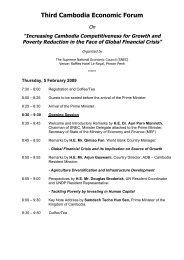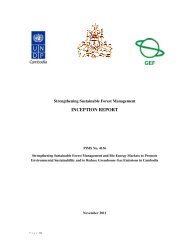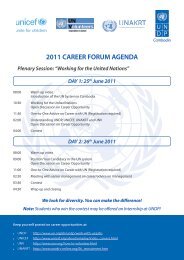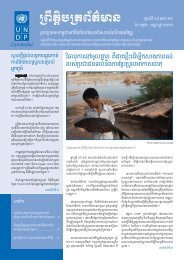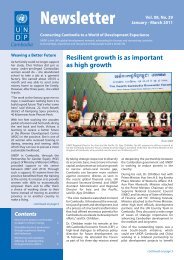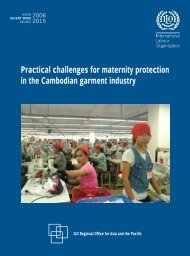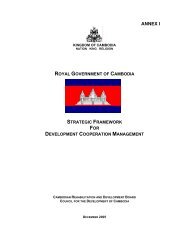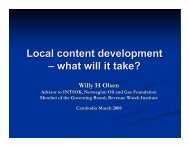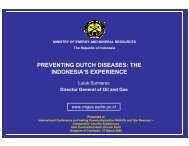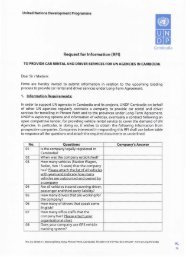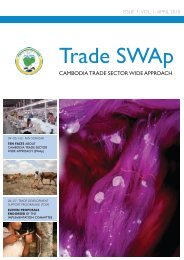UN Analysis Final.pdf - United Nations in Cambodia
UN Analysis Final.pdf - United Nations in Cambodia
UN Analysis Final.pdf - United Nations in Cambodia
Create successful ePaper yourself
Turn your PDF publications into a flip-book with our unique Google optimized e-Paper software.
However, the MoEYS 2004 Youth Risk Behaviour Survey (YRBS) among young people aged 11-18 found that<br />
only 43 per cent reported receiv<strong>in</strong>g education about drugs, nationwide. Interviewees said they learned<br />
about drugs from school (38 per cent), other organizations (2.7 per cent) and other sources (1.8 per cent).<br />
Only 40.6 per cent of the males and 42.5 per cent of the females reported awareness of drugs. Out-of-school<br />
youths had significantly lower awareness of illicit substances (10.2 per cent) compared to their <strong>in</strong>-school<br />
peers (78.8 per cent). About 43 per cent of the respondents aged 11-18 said that the best way to avoid<br />
us<strong>in</strong>g drugs was to avoid mak<strong>in</strong>g friends with drug users. Some 37.1 per cent suggested that young<br />
people should not try drugs, and 28.1 per cent proposed that they should stay away from drug users.<br />
Clearly there are some major discrepancies <strong>in</strong> the research <strong>in</strong> this area.<br />
6.2.3 YOUTH AND HIV AND AIDS<br />
<strong>Cambodia</strong> has made significant <strong>in</strong>roads <strong>in</strong> its efforts to prevent and fight HIV <strong>in</strong> recent years. Based on its<br />
periodic HIV Sent<strong>in</strong>el Surveillance (HSS) from 1995 to 2006, NCHADS reported <strong>in</strong> 2007 that the prevalence<br />
of HIV among the adult population (aged 15-49) had gradually decreased from 1.9 per cent <strong>in</strong> 1999 to<br />
0.9 per cent <strong>in</strong> 2006, after peak<strong>in</strong>g at 3.3 per cent <strong>in</strong> 1998. HIV prevalence is higher <strong>in</strong> urban than rural areas<br />
(Figure 6.3). The NCHADS estimate is higher than the 2005 CDHS estimate of 0.6 per cent, which NCHADS<br />
attributes to the fact that the 2005 CDHS covered only formal households and excluded non-household<br />
women at high risk of HIV <strong>in</strong>fection. The Asian Epidemic Model developed by NCHADS <strong>in</strong> 2007 predicted<br />
that the prevalence of HIV <strong>in</strong> adults aged 15-49 is expected to decl<strong>in</strong>e from 0.9 per cent <strong>in</strong> 2006 and to stabilize<br />
at 0.6 per cent after 2010.<br />
Although HIV prevalence among <strong>Cambodia</strong>n adults has decl<strong>in</strong>ed remarkably, issues relat<strong>in</strong>g to specific<br />
population groups must still be considered. Groups at high risk of HIV <strong>in</strong>fection are female sex workers (FSW),<br />
men who have sex with men (MSM) and <strong>in</strong>travenous drug users (IDU). Data on the prevalence of HIV among<br />
these groups gathered by HSS 2006 and NGOs (on women attend<strong>in</strong>g antenatal centres) showed that HIV<br />
prevalence among the FSWs stood at 12.6 per cent, down from 21.4 per cent <strong>in</strong> 2003 (NAA 2008). The<br />
National AIDS Authority (2008) notes that 7.2 per cent of this proportion consists of people younger than 25.<br />
The prevalence of STIs among MSM was 9.7 per cent <strong>in</strong> Phnom Penh and 7.4 per cent <strong>in</strong> the prov<strong>in</strong>ces<br />
(<strong>UN</strong>ICEF 2008a). Consistent condom use by this group is apparently low and many MSM have multiple<br />
sexual partners, <strong>in</strong>clud<strong>in</strong>g females. Stigma and discrim<strong>in</strong>ation result <strong>in</strong> many MSM be<strong>in</strong>g unable or unwill<strong>in</strong>g<br />
to access health services, <strong>in</strong>clud<strong>in</strong>g voluntary counsell<strong>in</strong>g and test<strong>in</strong>g (VCT) and prevention services,<br />
particularly young MSM (<strong>UN</strong>ESCO 2008, cited <strong>in</strong> <strong>UN</strong>ICEF 2008a). The 2003 KHANA study on MSM <strong>in</strong><br />
Phnom Penh, Battambang and Siem Reap supports this observation, f<strong>in</strong>d<strong>in</strong>g that condom use by MSM<br />
was low and <strong>in</strong>consistent, and that their knowledge of safe sex practices and HIV and AIDS was uneven,<br />
plac<strong>in</strong>g many young men at risk of HIV <strong>in</strong>fection, as well as the young women who have sex with them.<br />
HIV prevalence rates among pregnant women aged 15-24 attend<strong>in</strong>g antenatal cl<strong>in</strong>ics has rema<strong>in</strong>ed fairly<br />
stable between 2003 and 2006; at an estimated 0.36 per cent and 0.41 per cent, respectively (HSS 3003 and<br />
2006). Recent research has found that approximately 43 per cent of new <strong>in</strong>fections are occurr<strong>in</strong>g <strong>in</strong> married<br />
women aged 15-49. Most are believed to have been <strong>in</strong>fected by their husbands (NAA, 2008). HIV prevalence<br />
rates for youth are not available <strong>in</strong> HSS 1995-2006 or CDHS 2000. However, the 2005 CDHS gives an estimate<br />
of 0.2 per cent for youths aged 15-24. Figures for females and males <strong>in</strong> this age cohort were 0.3 per cent<br />
and 0.1 per cent, respectively.<br />
Situation <strong>Analysis</strong> of Youth <strong>in</strong> <strong>Cambodia</strong><br />
71




